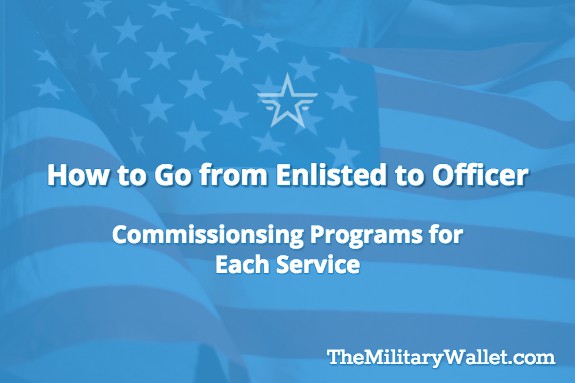Table of Contents
The United States Armed Forces has a long and proud history of enlisted service members surging up through the ranks and ending their careers as commissioned officers. These tough as nails and hard-working service members are known colloquially as “mustangs” and their journey from enlisted to officer is not always an easy one.
One of our country’s most famous mustangs was an enlisted Private in Union Army who received a battlefield commission as a sergeant for valor under fire at the Battle of Antietam in 1862. After mustering out of the Army as a major, this man, William McKinley, became the 25th President of the United States.
Any currently enlisted man or woman who has courage, work ethic, moral character and integrity, and decent grades has what it takes to become a commissioned officer in the United States Armed Forces. Enlisted members who become officers can expect to continue advancing both on and off the field throughout their military careers.
Before you start pursuing the path from enlisted to officer, understand that the avenues to officer commissioning are fiercely competitive. If you are an enlisted member of the armed forces, research the following enlisted to officer programs, which are the most common avenues available for service members to pursue commissioning. If you have what it takes, you can look forward to a career with higher pay and more leadership responsibilities.
Officer Commissioning School (OCS)
Enlisted military members of any branch with at least a bachelor’s degree can request to go to their respective OCS. Training concentrates on military subjects such as command leadership and combat operations. Upon graduation, previously enlisted members become officers. Competition is strong, and applicants must usually have a bachelor’s degree or higher in order to apply, and usually have to compete in a rigorous board process.
If you’re currently enlisted and don’t yet have your degree, you have the option to use your education benefits to complete school while serving on active duty. Here are the respective Tuition Assistance Programs for each military branch:
- Air Force Tuition Assistance
- Army Tuition Assistance
- Coast Guard Tuition Assistance
- Marine Corps Tuition Assistance
- Navy Tuition Assistance
Also, depending on which branch you serve, there are additional programs in place to help enlisted members transition to becoming a commissioned officer. The following is a list of the main enlisted to officer programs according to branch.
ADVERTISEMENT
ROTC – Reserve Officer Training Corps
The Reserve Officer Training Corps (ROTC) is a long-standing program that commissions thousands of officers each year. ROTC offers both scholarship and no-scholarship programs. Upon completing your college degree and your ROTC program, you will be commissioned into your branch of service. While you cannot attend ROTC while serving on active duty, you may be eligible to participate in ROTC if you apply after leaving the military. Some branches also offer programs that will allow you to leave active duty early to enroll in a college degree program and an ROTC program.
ADVERTISEMENT
Air Force Commissioning Programs
The Airman Scholarship and Commissioning Program (ASCP) allows enlisted personnel to separate from active duty and receive a scholarship worth up to $15,000 per year while pursuing their commission through Air Force ROTC.
The SOAR program, of Scholarships for Outstanding Airmen to ROTC, allows enlisted personnel to separate from active duty and receive a scholarship worth up to $18,000 per year while pursuing their commission through Air Force ROTC. Students may not pay the difference to attend higher-cost schools. The SOAR scholarship program includes an annual textbook allowance and a monthly nontaxable stipend. This scholarship will be awarded for 2 to 4 years, depending on how many years you have remaining in your bachelor’s degree program. Graduates commission as a 2nd Lieutenant and return to active duty. There is a 4-year service obligation on active duty, plus a 4-year Reserve obligation.
Air Force ROTC (AFROTC) Professional Officer Course-Early Release Program (POC-ERP) offers active duty Air Force enlisted personnel an opportunity for an early release from active duty to enter AFROTC and receive a commission as an Air Force Officer.
Members selected for the POC-ERP will separate from active duty, sign a contract with AFROTC and become full-time college students. The program is open to undergraduate degrees only. Upon completion of all degree and commissioning requirements, cadets are commissioned as second lieutenants and returned to active duty for a period of at least four years.
Additional Education & Commissioning Opportunities: The Air Force has several other programs for earning your degree and applying for a commission. You can learn more at the Air Force website.
ADVERTISEMENT
Army Enlisted Commissioning Programs
The Army has three commissioning programs for enlisted members, in addition to the United States Military Academy at West Point. They are:
- Green to Gold
- Army Medical Department Enlisted Commissioning Program (AMEDD AECP)
- Inter-service Physician Assistance Program (IPAP)
1. Green to Gold features four different options – the Active Duty Option, Scholarship Option, Hip Pocket Option, and Non-Scholarship Option.
- The Green to Gold Active Duty Option is a two-year program that allows active duty enlisted soldiers the opportunity to complete their bachelor’s degree or a two-year graduate degree and then commission as an Army officer. Soldiers selected to participate in this program will continue to receive their current pay and allowances while in the program (up to a maximum of 24 consecutive months). More info.
- Green to Gold Scholarship Option. This is just what it sounds like. Soldiers can be considered for a two-, three-, or four-year scholarship. Scholarship winners receive tuition or room and board support, and additional money for textbooks, supplies, and equipment. Recipients also receive a monthly stipend for up to 10 months each school year that increases each year based on your Military Science Class.
- Hip Pocket Scholarship. This program is available to active duty soldiers, and is awarded at the discretion of the commanding general. Recipients separate from active duty to attend Reserve Officers’ Training Corps (ROTC) on a two, three, or four-year scholarship. More info on the Hip-Pocket Program.
- Non-scholarship. This program allows active duty Soldiers to attend ROTC in a non-scholarship billet. Members must be within two years of their bachelor’s degree. Participants receive a monthly stipend of up to 10 months each school year.
2. Army Medical Department Enlisted Commissioning Program (AMEDD AECP). The AMEDD AECP is an Army commissioning program for nurses. You can learn more at the AMEDD AECP webpage.
3. Inter-service Physician Assistance Program (IPAP). The IPAP is for qualified Physician Assistants. Learn more at the IPAP website.
Army Warrant Officer Appointment Process
Those interested in becoming Warrant Officers must be selected for Warrant Officer Candidate School (WOCS), which is generally held in Fort Rucker, Alabama. WCOS focuses on training similar to OCS and is designed to assess candidates’ potential for appointment as Warrant Officers and prepare them for service in 16 of the Army’s 17 branches.
After a candidate completes WOCS, he or she is appointed as a Warrant Officer (WO1). Graduates are then sent to their specific U.S. Army branches, where they receive more focused technical training in their specialties.
Coast Guard Commissioning Programs
The Coast Guard offers several different programs which help enlisted members of the Coast Guard become an officer. Details of each program (which are too broad for the spectrum of this article) can be found in the United States Coast Guard OCS Website. The website will guide any enlisted member in how to apply for one of the Coast Guard officer programs.
Marine Corps Enlisted Commissioning Educational Program (MECEP)
Applications to the Marine Corps Enlisted Commissioning Educational Program is open to all active duty Marines and Marines in the Active Reserve. The MECEP program allows selected Marines to transition from enlisted to officer by attending a four-year college full-time while maintaining active duty status and pay.
Selection into MECEP is based on the Marine’s service record, previous academic record, and potential for commissioned service. Selected Marines attend a 10-week Officer Candidate School before going on to a college or university with an NROTC program. Once they complete the program, they’re commissioned as second lieutenants.
Navy Seaman to Admiral Program (STA-21)
Applicants for the Seaman to Admiral Program (STA-21) must meet several requirements to qualify for the process, including:
- American citizenship
- A high school diploma or GED
- The ability to complete a baccalaureate degree in 36 months upon acceptance into the program
- Physical fitness standards for commissioning
Sailors who are interested in the program must submit a package which will be reviewed once each year with all of other submitted packages.
The STA-21 program keeps participants on active duty at their current enlisted pay grade while also giving each sailor $10,000 per year to cover tuition, books, and fees.
Sailors who are conditionally accepted into the program must remain fully eligible until they have completed their approved degree program, at which point they would receive their appointment as an ensign in the U.S. Navy.
Getting Started
If you’re trying to go through one of these programs and you feel like you don’t have enough information to proceed with the application process, contact your branch’s local recruiting office. They will be able to guide you in the right direction to help you reach your career goals through the Armed Forces.
Also, make sure to speak with your commanding officer and express interest in going from enlisted to officer. They will be able to point you in the right direction or get you in contact with the people necessary to get the ball rolling on your application process. If you have the drive, you’ll be able to reach your goal of going from enlisted to officer.
There are additional opportunities to apply to one of three military service academies: West Point, The Air Force Academy, and the Naval Academy. Each service academy has a rigorous application process with strict requirements. The officer to enlisted programs noted above are available to currently enlisted active duty or reserve duty service members who are past the age of enrollment for service academies.




About the comments on this site:
These responses are not provided or commissioned by the bank advertiser. Responses have not been reviewed, approved or otherwise endorsed by the bank advertiser. It is not the bank advertiser’s responsibility to ensure all posts and/or questions are answered.